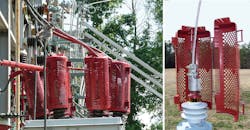Squirrels caused 3,456 outages in 2016 alone, causing power loss for almost 200,000 customers, according to the American Public Power Association. Many of those outages occurred in Gastonia, North Carolina, a suburb of Charlotte.
For example, two large oak trees on a golf course attracted countless curious squirrels into a substation managed by the City of Gastonia Public Utilities. Because this particular substation served as a “squirrel hotel,” the North Carolina utility found it nearly impossible to keep the substation online.
Two weeks in a row, the squirrels snuck into the substation and crawled on top of the equipment, knocking out the power to the substation and the local residents. The outages both happened during the daytime, causing unexpected power outages to 5,000 customers.
While the duration of the outages depended on the extent of the damage, they often lasted for about an hour. Each repair cost anywhere from a few hundred dollars to thousands of dollars. One extreme case had $15,000 in repairs.
Rather than waiting for another squirrel-caused outage, the City of Gastonia Electric Utilities took action. The team tried covering up its equipment and lines with homemade contraptions made of PVC piping, but they only provided a temporary deterrent. As such, the utility searched for a more permanent solution.
Deterring Squirrels
To keep squirrels out of substations, utilities can place mothballs at the entrance or install different types of fencing. If a squirrel wants to get into a substation, however, the animal can easily access it from above by crawling up poles and across wires.
To prevent overhead access to its substations, Gastonia installed the Squirrel Guard Disc (BISG), which acts as a barrier to stop squirrels from getting electrocuted. The discs, which are manufactured by TE Connectivity, are made with a proprietary process to help them withstand UV exposure and electrical discharge.
If they do find their way into the substations, however, a device needs to deter them from crawling on the equipment and causing power outages. TE Connectivity introduced several time-tested deterrents that prevent squirrels from stepping from a live bus to a grounded surface on the top of a regulator, transformer or breaker. As such, it prevents the squirrel from being electrocuted and keeps the power on.
Rather than having to take the equipment off line to install the protective devices, two technicians can install the discs with hot sticks while the substation is still energized.
Protecting Substations
In addition to the discs, Gastonia also installed BCAC-IC protective cages, which are made from a non-conductive, non-tracking material. Because they feature an open structure, substation technicians can see inside to inspect the bushing. Also, rain water can wash off the porcelain inside and prevent any buildup of debris, such as acorns left by squirrels.
With just a few snaps, the substation team can clamp the protective cover shut around each bushing. The cage-like structure is designed to protect breaker and transformer bushings, making it impossible for any animal to touch any part of the substation that would complete a power arc. The products are said to last if the equipment they were designed to protect, which is up to 40 years in some cases.
Several of Gastonia’s substations are protected by the products, and the city plans to safeguard all 11 of its electrical substations from squirrel invasions to keep the power on for its 28,000 customers.
While the squirrels will never stop trying to make their way into the substations, the devices have served as an effective deterrent. So far, the outages have dropped by 75%, and the number of squirrel fatalities due to electrocution has plummeted.




